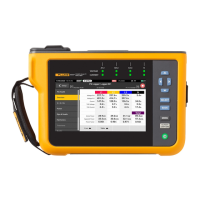3 Phase Power Quality Analyzer
Measurement Configuration
29
Event Trigger Settings
The capture of events requires trigger settings. A set of standard settings are enabled by
default. These triggers are to specify when a detailed RMS capture occurs in the Analyzer. The
1775 and 1777 models also include a waveform and transient capture as well as the detailed
RMS voltage capture.
The available settings are:
Dip
Swell
Interruption
Waveshape Deviation
Transients
Rapid Voltage Change
Inrush Current
For more details about each of these event settings, see Glossary.
Dips and Swells. For dips and swells the capture is based on the RMS voltage expressed as a
percentage of the nominal voltage.
The defaults for these settings are 90 % and 110 %. This means that for a 230 V nominal the
voltage must drop by 23 V to capture, and a swell capture is triggered at 253 V. Hysteresis of
2 % is automatically assumed, this means that the event is considered to have ended if the 2 %
recovery within 90 % or 110 % of voltage is made. This setting ensures that multiple events are
not captured for a single event. The setting of this voltage is considered from a standard
averages period of 200 ms or a sliding reference is applied. This reference considers the last
10 cycles for 50 Hz or 12 cycles for 60 Hz.
Use a sliding reference where the nominal voltage can vary more freely. This is usually the case
in high voltage systems. When you apply the sliding reference, the Analyzer detects dips and
swells based on a voltage change relative to the actual rms voltage, rather than, the absolute
nominal voltage.
Interruptions. Interruptions are events when a total power loss is made at the load across all
measured phases. This could be a blown fuses, a breaker tripping, or utility power loss. In the
case of power loss, the default value is 5 % of the nominal voltage. You can increase this
voltage if the registration of the interruption is not correctly represented or if the electrical
system is supported for several cycles by inductive or capacitance effects in the system. An
automatic hysteresis of 2 % is applied.
Waveshape Deviation. The deviation of the waveform considers the consecutive waveform
based on sample-to-sample comparison of the waveform. The trigger starts when the
magnitude of each cycle is compared with the sample magnitude on the next cycle. This is
expressed as a percentage of the nominal voltage. The default setting is 10 % of voltage. To
activate this trigger, check the Trigger On box.

